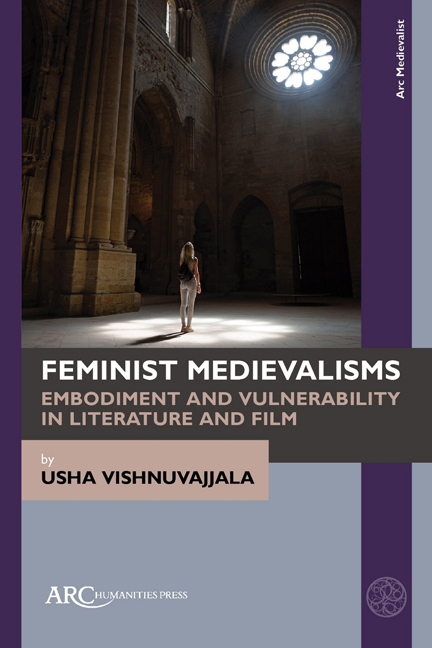Book contents
- Frontmatter
- Contents
- Acknowledgements
- Introduction
- Chapter 1 Nested Medievalisms and Affected Bodies in Jane Austen’s Northanger Abbey
- Chapter 2 Feminism and Medievalism in Woolf’s Final Works
- Chapter 3 Medievalism as Feminist Sanctuary in the late Twentieth Century
- Chapter 4 Chaucer, Vulnerable Bodies, Somatophobia, and Theory
- Conclusion: Feminisms and Medievalisms
- Select Bibliography
- Index
Conclusion: Feminisms and Medievalisms
Published online by Cambridge University Press: 28 March 2024
- Frontmatter
- Contents
- Acknowledgements
- Introduction
- Chapter 1 Nested Medievalisms and Affected Bodies in Jane Austen’s Northanger Abbey
- Chapter 2 Feminism and Medievalism in Woolf’s Final Works
- Chapter 3 Medievalism as Feminist Sanctuary in the late Twentieth Century
- Chapter 4 Chaucer, Vulnerable Bodies, Somatophobia, and Theory
- Conclusion: Feminisms and Medievalisms
- Select Bibliography
- Index
Summary
THE ROLE of medievalism in ideas about gendered experiences of embodied vulnerability is complex, as I’ve attempted to demonstrate by looking at a careful selection of feminist engagements with medievalism over the past three centuries. This medievalism, even when it seems incidental to texts (as in Austen’s and Woolf’s novels) and even when those texts are popular and rarely given serious scholarly attention (as in Madonna’s and Lambert’s video and Ardolino’s film), is worthy of consideration alongside studies of intellectual engagements with the idea of the Middle Ages. As Austen’s Catherine Morland attempts to argue in Northanger Abbey, “real solemn history” is not only doing a disservice to women by leaving out their stories, but is also incomplete and doing a disservice to understandings of history. In her depiction of Catherine, Austen was engaging with philosophical debates circulating during her life about sensory experience and judgement and putting those debates in conversation with her lifelong interest in the women’s histories that history-writing leaves out. Woolf, similarly, puts the history of women’s exclusion from much of public life in conversation with narratives about national and martial history, pairing her scathing critique of institutions that shore up nationalism and misogyny in Three Guineas with a depiction of the much richer history of lived experiences repeatedly breaking through a pageant-play that attempts to tell a familiar story of national origins in Between the Acts. Like Austen, she shows us that the exclusion of women’s stories and practices does not only harm women; it harms everyone.
Austen and Woolf rarely enter conversations about medi evalism, and especially complex medi evalism—the kind that deals with the subtlety of ideas about the Middle Ages in texts not set in the Middle Ages or adapting medi eval texts—despite the frequency with which their male contempo-raries do. Part of my goal in this book has been to challenge the hierarchies with which we treat medi evalisms and which, I hope I have shown here, are also tied up in the hierarchies with which we treat medi eval texts; those in turn are often tied up in gender and how we treat women’s stories, women’s writing, and forms of affinity, affect, and affiliation associated with the feminine.
- Type
- Chapter
- Information
- Feminist MedievalismsEmbodiment and Vulnerability in Literature and Film, pp. 127 - 128Publisher: Amsterdam University PressPrint publication year: 2024



